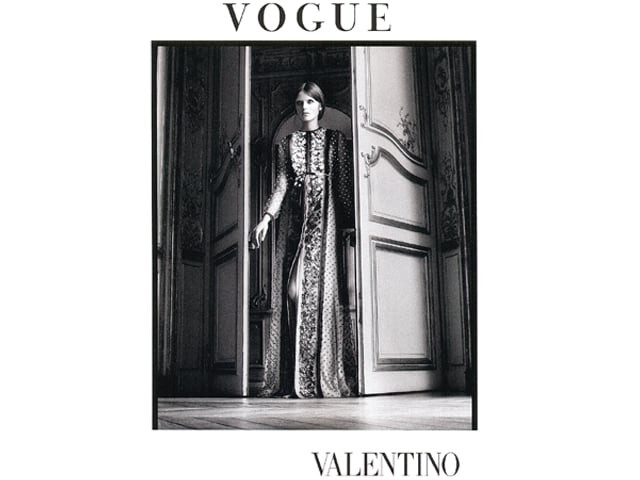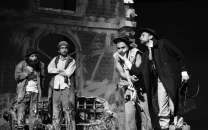Trendsetters plagiarise?
A Valentino ad in this month’s American Vogue has sent ripples down the fashion industry.

Although this question has plagued the industry for a while now, it has become especially relevant with the onslaught of fashion weeks where many a designer have been shocked by an unabashed Xerox of their designs calmly walking past them on a glitzy ramp. Without copyrights and patents, the only thing designers can do is launch diatribes to fashion fellows in the fraternity or to take it step further, to the fashion media. Designer labels that are often copied are Sana Safinaz, TeeJays and Elan and while Sana Hashwani and Safinaz Munir, Feeha Jamshed and Khadija Shah may not have rights over the initiation of the trailing hemlines and embroidered motifs, the jump suit and the bejewelled neckline respectively, these designs have come to symbolise the brands’ unique aesthetic.
However, Truck art, dastar-khan and Kalash motifs do not fall into the same category. These are emblems of our culture, a culture that defines itself by being shared collectively within a populace. Therefore the truck wala has no rights to those designs as does the designer that employs those symbols. Gulabo may have initiated truck art into fashion, but what has given the design agency and popularity is the myriad ways in which brands such as Kamiar Rokni, and this year, Khaadi and Chinyere have picked up on the trend and made it entirely their own. A ‘Folkistan’ piece does not look like a ‘Rang Ja Pakistan’ ensemble, and this what makes a design unique, even if it is inspired from culture and a ‘trend’.
The Kalash theme has become a hot trend since Pakistan Institute of Fashion Design (PIFD) graduate Akif Mehmood resurrected it for the runway. In a clever business move, Turquoise, a clothing store in Lahore, picked up on the style instantly and managed to sell out even before its official launch. Does Mehmood have the right to berate the store? No; without replication, fashion cannot exist. Reproduction of a design is the very essence of what creates a trend and subsequently takes fashion forward. Indeed what the industry is doing at fashion weeks is picking up on styles that are frequently spotted on runways and labelling them as the next hot thing.
What lends this plagiarism versus trend debate a whole new angle, however, is the appearance of a Valentino advertisement in this month’s American Vogue that has sent ripples down the industry in conversely, both indignation and pride. A tall statuesque model stands through a door way in a structured long open gown with a floral motif band running down both its sides.
The lady to have spotted this first is Frieha Altaf, Sana Safinaz’s PR manager. “I saw this picture and thought ‘Holy s**t!’ It is definitely a Valentino and also put up on their official website but it is so close to a Sana Safinaz!” exclaimed an excited Altaf. “This is nothing new in the fashion world; in 1993 we did a fashion show on a train station and seven months later Tarun Talhiani told me that Gaultier had just done one in a train station in Paris and then some years later Galliano did a fashion show at a train station! Does that mean Galluiano stole Gaultiers idea … and Gaultier actually stole my idea? No. It just means that the creative minds think alike,” says Altaf.
Millions of women who hoarded Sana Safinaz’s lawn exhibitions last year however, can testify that the floral motif design and the general silhouette of the garment on the Valentino advertisement is a quintessential representation of the brand’s aesthetic. So what has happened here? Has the house of Valentino copied a Sana Safinaz design or is it simply that patterns of ubiquitous designer labels float all over the world and can and do inspire other brands? “You can’t accuse Valentino of copying,” says Altaf matter of factly. “Anyone can be inspired by their designs. They’re everywhere,” she commented referring to the Verve magazine cover with the Ambanis and an Indian Vogue feature of the designer duo.
Designers Sana Safinaz however are pleased by this coincidence, “I found it very flattering and then amusing when people started calling us to ask whether we had started working for Valentino,” said Munir.
So is this a case of plagiarism or inspiration? “This is exactly what inspiration is all about. It shows a flow of fashion from east to west and vice versa. Global trends now have a great fusion vibe,” said Munir who will not be approaching Valentino for clarification. “It looks inspired by the east but is definitely not a copy. If anything, one should be flattered.”
Coming from possibly the largest design house in the country in terms of production and popularity, perhaps other designers who often find themselves in similar situations can find solace in the fact that copying is a latent way of paying tribute. One hopes with this example one doesn’t have to hear another spiel on how a cultural symbol belongs to a certain designer because he/she revived it and the designer in question moves on to defining the next big thing that can be credited to his/her name.
Published in the Express Tribune, February 4th, 2011.



















COMMENTS
Comments are moderated and generally will be posted if they are on-topic and not abusive.
For more information, please see our Comments FAQ